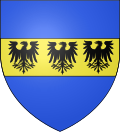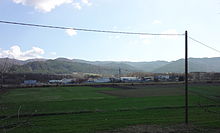Aiglun, Alpes-de-Haute-Provence
Aiglun (French pronunciation: [ɛɡlœ̃]) is a commune in the Alpes-de-Haute-Provence department in the Provence-Alpes-Côte d'Azur region in southeastern France.
[3] Aiglun is located about 6 km southeast of Digne following Route nationale N85, which runs mostly parallel to the Bléone river which forms the southeastern border of the commune.
[9] Finally, the pipeline for feeding natural gas to Digne passes through the commune and is thus an additional risk factor.
[11] The commune has been the site of several natural disasters: an earthquake in 1984, floods and mudslides in 1996 and 2001, drought in 1989, 1990, and 1998, and landslides in 1996.
[6][12] The earthquake of 19 June 1984 had its epicentre in Aiglun and a macro-seismic intensity of VI on the Medvedev–Sponheuer–Karnik scale (MSK).
[13] The name of the town appears for the first time in texts of 1195 (according to Rostaing and Nègre) in the form: Aiglezino (and Aygladuno in 1319).
[16] In ancient times, the Bodiontiques (or Bodiontici) inhabited the valley of the Bléone, and so it was Gallic people who lived in what is now the commune of Aiglun.
The Bodiontiques, who were defeated by Augustus Caesar at the same time as other people living in the area of the Tropaeum Alpium (from 14 BC to 14 AD), were attached to the Roman province of Alpes-Maritimes at its creation.
[17] The Roman road linking Sisteron to Vence crossed the territory of the present commune.
[20] On the secular side, the village was divided between multiple lords (similar to feudal barons) which by 1315 had reached 22 in number.
[21] The village was an ancient fortress called castrum de Aglenio in the Middle Ages.
[19] At the end of the Second World War, the Liberation of Aiglun was marked by the passage of a column of the U.S. 36th Infantry Division on 19 August 1944, coming from Malijai as reinforcements to secondary column stopped at Digne, to outflank the German garrison at Digne.
[34] Two of the largest employers in the commune are responsible for service activities: The mayoral election was an innovation of the French Revolution of 1789.
Its construction used anachronistic techniques such as: The church contains many items which have been listed as historical objects: The cemetery church contains many items that are listed as historical objects: The chapel of Saint John is on the road leading to Saint John, connecting the town centre to Old Aiglun.






